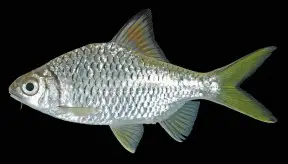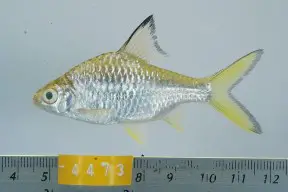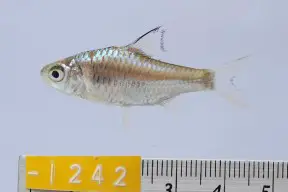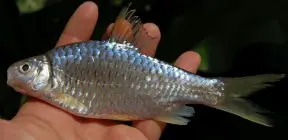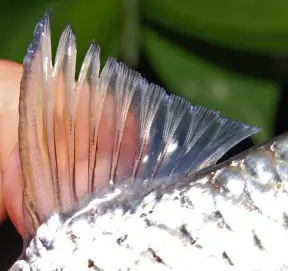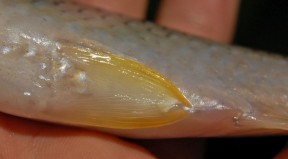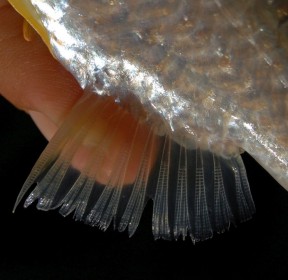Mystacoleucus obtusirostris
SynonymsTop ↑
Barbus obtusirostris Valenciennes, in Cuvier & Valenciennes, 1842; Barbus marginatus Valenciennes, in Cuvier & Valenciennes, 1842; Mystacoleucus marginatus (Valenciennes, in Cuvier & Valenciennes, 1842); Puntius siamensis Sauvage, 1883
Etymology
Mystacoleucus: from the Ancient Greek μύσταξ (mústaks), meaning ‘upper lip, moustache’, and the generic name Leuciscina, which is not currently in use.
obtusirostris: from the Latin obtusus, meaning ‘dull, blunt’, and rostrum, meaning ‘snout’, in reference to this species’ truncated snout.
Classification
Order: Cypriniformes Family: Cyprinidae
Distribution
M. marginatus is the most widely-distributed member of the genus with a range extending eastwards from Myanmar through southwestern China, Thailand, Laos, Cambodia, and Vietnam, and to the south through Peninsular Malaysia to the Greater Sunda Islands of Borneo, Sumatra and Java.
It occurs in several major river systems including the Mekong, Chao Phraya, Mae Klong, Batang Hari, and Kapuas, with populations varying somewhat in terms of colour pattern.
Type locality is ‘Indonesia: Java: Buitenzorg [Bogor]’.
Habitat
Predominantly a riverine fish favouring clear, well-oxygenated, running water with substrates of sand or gravel and often present in rock and boulder-filled headwater streams. As a result of damming and other human interferences it now also inhabits some lakes and reservoirs.
Maximum Standard Length
130 – 140 mm.
Aquarium SizeTop ↑
An aquarium with base dimensions of 120 ∗ 45 cm or equivalent should be the minimum size considered.
Maintenance
Choice of décor is not as critical as water quality and the amount of open swimming-space provided but this species is perhaps best-suited to an environment resembling a flowing stream/river with a substrate of variably-sized, water-worn rocks, sand, fine gravel and perhaps some small boulders.
This can be further furnished with driftwood roots or branches, and aquatic plants such as Microsorum, Bolbitis or Anubias spp. can be grown attached to the décor.
Since it naturally occurs in pristine habitats it is intolerant to accumulation of organic pollutants and requires spotless water in order to thrive. Though torrent-like conditions are unnecessary it also does best if there is a high proportion of dissolved oxygen and moderate water movement. Weekly water changes of 30-50% aquarium volume should be considered mandatory.
Water Conditions
Temperature: 20 – 27 °C
pH: 6.0 – 8.0
Hardness: 36 – 268 ppm
Diet
Likely to be a generalised omnivore in nature. Stomach analyses of the congener M. marginatus showed it to feed on insects, crustaceans, worms, algae and aquatic plants, though it’s unclear if the latter two were taken directly or via the stomach contents of prey items.
In the aquarium it is easily-fed but for it to develop its best colours and condition offer regular meals of small live and frozen foods such as chironomid larvae (bloodworm), Daphnia and Artemia along with good quality dried flakes and granules; at least some of the latter should contain added plant material such as Spirulina.
Behaviour and CompatibilityTop ↑
Not aggressive but can upset slow-moving or timid tankmates with its vigorous behaviour, especially when feeding, so is best maintained alongside robust, similarly-sized fishes, especially cyprinids, loaches and other riverine species.
This species exists in schools in the wild therefore a group of six or more should be the smallest considered.
Sexual Dimorphism
Sexually mature females are likely to be deeper-bodied than males.
Reproduction
Unrecorded in aquaria. In nature spawning occurs during the wet season, from April to September.
NotesTop ↑
This species is occasionally marketed as ‘Burmese Rainbow Barb’ in the ornamental trade. others may have been exported in small numbers or as bycatch among shipments of other species.
It was referred to as Mystacoleucus marginatus for decades, but that name is a simultaneous subjective synonym of M. obtusirostris following Kottelat (2013).
M. obtusirostris can be distinguished from congeners by the following combination of characters: 24-26 + 2 lateral line scales; 14 circumpeduncular scale rows; anal-fin with a convex distal margin; dorsal-fin with black anterior and distal margins; caudal-fin with black distal margin; most body scales with a black, crescent-shaped base.
All Mystacoleucus species possess a procumbent predorsal spine orientated towards the head, though it can be difficult to spot with the naked eye. This can become entangled in an aquarium net so care must be taken when handling the fish.
The trait is shared by members of Tor, Spinibarbus and Paraspinibarbus although there exists no strong evidence to suggest that these genera form a monophyletic lineage and it’s likely that they developed the spine independantly of one another. Mystacoleucus spp. can be further identified by the presence of 6-10 branched anal-fin rays and 24-39 lateral line scales.
References
- Cuvier, G. and A. Valenciennes , 1842 - Histoire naturelle des poissons v. 16: i-xx + 1-472
Tome seizième. Livre dix-huitième. Les Cyprinoïdes. - Chu X. L. and M. Kottelat, 1998 - Japanese Journal of Ichthyology 36(1): 1-5
Paraspinibarbus, a new genus of cyprinid fishes from the Red River Basin. - Freyhof, J., D. V. Serov, and T. N. Nguyen, 2000 - Bonner Zoologische Beiträge 49(1-4): 93-99
A preliminary checklist of the freshwater fishes of the River Dong Nai, South Vietnam. - Kottelat, M., 1998 - Ichthyological Exploration of Freshwaters 9(1): 1-128
Fishes of the Nam Theun and Xe Bangfai basins, Laos, with diagnoses of twenty-two new species (Teleostei: Cyprinidae, Balitoridae, Cobitidae, Coiidae and Odontobutidae). - Kottelat, M., 2001 - WHT Publications, Colombo: 1-198
Fishes of Laos. - Kottelat, M., 2013 - Raffles Bulletin of Zoology Supplement 27: 1-663
The fishes of the inland waters of southeast Asia: a catalogue and core bibiography of the fishes known to occur in freshwaters, mangroves and estuaries. - Kottelat, M. and E. Widjanarti, 2005 - Raffles Bulletin of Zoology Supplement 13: 139-173
The fishes of Danau Sentarum National Park and the Kapuas Lakes area, Kalimantan Barat, Indonesia. - Lim, K. K. P., P. K. L. Ng, and M. Kottelat, 1990 - Bulletin of the Raffles Museum 38(1): 31-54
On a collection of freshwater fishes from Endau-Rompin, Pahang-Johore, Peninsular Malaysia. - Ng, H. H. and H-H. Tan, 1999 - Zoological Studies 38(3): 350-366
The fishes of the Endau drainage, Peninsular Malaysia with descriptions of two new species of catfishes (Teleostei: Akysidae, Bagridae). - Roberts, T. R., 1993 - Zoologische Verhandelingen (Leiden) 285: 1-94
The freshwater fishes of Java, as observed by Kuhl and van Hasselt in 1820-23. - Tan, H. H. and M. Kottelat, 2009 - Ichthyological Exploration of Freshwaters 20(1): 13-69
The fishes of the Batang Hari drainage, Sumatra, with description of six new species.







